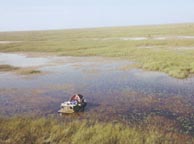Integrated Geochemical Studies in the Everglades - Mercury Cycling and Bioaccumulation
 |
Project Investigators: William H. Orem, David P. Krabbenhoft and George Aiken
Project Personnel: Mark L. Olson, John F. DeWild, Shane D. Olund, M. Tate and M. Schmidt |
| Summary |
| The scientific focus of this project is to examine the complex interactions of contaminants (synergistic and antagonistic), ecosystem responses to variations in contaminant loading (time and space dimensions), and how imminent ecosystem restoration steps may affect existing contaminant pools. |
This project is an integration of a number of individual but interrelated tasks that address environmental impacts in the south Florida ecosystem using geochemical approaches. Externally derived nutrients, mercury and sulfur are three of the most important contaminants currently affecting this ecosystem. Other contaminants of concern include anthropogenically produced organic substances (pesticides, herbicides, polycyclic aromatic and aliphatic hydrocarbons) and other metals. The scientific focus of this project is to examine the complex interactions of these contaminants (synergistic and antagonistic), ecosystem responses to variations in contaminant loading (time and space dimensions), and how imminent ecosystem restoration steps may affect existing contaminant pools. The Everglades restoration program is prescribing ecosystem-wide changes to some of the physical, hydrological and chemical components of this ecosystem. However, it remains uncertain what overall effects will occur as these components react to the perturbations (especially the biological and chemical components) and toward what type of "new ecosystem" the Everglades will evolve. The approaches used will be extensions of previous efforts by the lead investigators, whereby we will enhance our abilities to address land management and ecosystem restoration questions. Major changes implemented in this project will include the use of environmental chambers (controlled enclosures or mesocosums) and isotopic tracers to provide a more definitive means addressing specific management questions, such as "What reductions in toxicity (methylation and bioaccumulation) would be realized if atmospheric mercury emissions were reduced by 75%?" or, "Over what time scales could we expect to see improvements to the ecosystem if nutrient and sulfur loading were reduced by implementation of agricultural best management practices and the storm water treatment areas (STA)?" Results of these geochemical investigations will provide critical elements for building ecosystem models and screening-level risk assessment for contaminants in the ecosystem, and this project will be closely linked with projects addressing ecosystem modeling (Reed Harris, Everglades and TMDL mercury modeling) and risk assessments (Tim Gross, USGS, Gainesville, FL).
Proposal
Project Summaries
Work Plans
- 2003 (Mercury Cycling, Methylation and Bioaccumulation)
- 2004 (Integrated Biogeochemical Studies in the Everglades; Mercury Cycling and Bioaccumulation)
Metadata
Publications
- Source Identification of Florida Bay's Methylmercury Problem: Mainland Runoff versus Atmospheric Depostion and In Situ Production (from the GEER Conference, April 2003)
Open File Reports:
- Geochemistry of Sulfur in the Florida Everglades: 1994 through 1999 (OFR-01-007)
- Geochemistry of Surface and Pore Water at USGS Coring Sites in Wetlands of South Florida: 1994 and 1995 (OFR-97-454)
Paper:
- Binding of Mercury(II) to Dissolved Organic Matter: The Role of the Mercury-to-DOM Concentration Ratio
Report:
- Tracing sources of sulfur in the Florida Everglades
Abstract:
Related Links
- Application of Stable Isotope Techniques to Identifying Foodweb Structure, Contaminant Sources, and Biogeochemical Reactions in the Everglades (Kendall's project page)
- Integrated Biogeochemical Studies in the Everglades: Nutrients and Sulfur (Orem's project page)
This page is: http://sofia.usgs.gov /projects/int_geochem/index.html
Comments and suggestions? Contact: Heather Henkel - Webmaster
Last updated: 27 August, 2004 @ 05:40 PM (HSH)
